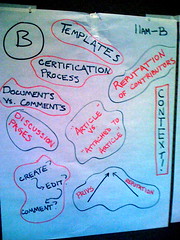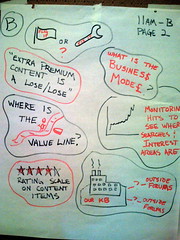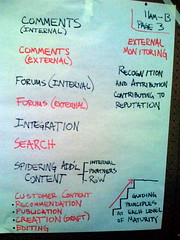
A nice writeup on myCRMcareer from the folks over at Chief Marketer. (Cerado Haystack is the social networking engine behind myCRMcareer.) Read the whole bit here.
Rex Hammock:Viewing Presentations On Your iPhone
When I ran into Jerry last week at the Consortium summit, he showed me a cool little bit where Google Docs / Presentation functionality was specifically tuned for the iPhone. Just did a quick search, and Rex Hammock has put up a quick (90sec) video on how to do it. Check it out.
Offtopic: CommonCraft, The Zombie Edition
Lee and Sachi give some brilliant instruction on how to survive a zombie invasion. Braaaains!
Monkey, Sí
David Cushman has started a new Facebook group called "No More Call Center Monkeys!"
He also distilled down a number of his key points thusly:
- I want to talk to someone who is listening to me – not reading a script from a computer screen.
- I want to talk to someone with the power to do something about my problem.
- I want to talk to someone who knows how to get round the moment when ‘the computer says no’
- I want to talk to smeone for whom reason is allowed to mean something.
- I don’t want to input my account number on my phone – then have to tell three more people what it is during the same call.
- I want a full response to my complaints.
We urge these companies to stop insulting the intelligence of both their customers AND their employees. Giving the poor saps on the end of the phone a script they must stick to effectively turns them into a computer. We don’t want to talk to a computer.
We think it is grossly unfair on call centre staff – the very people charged with dealing direct with your customers – to leave them with no power to think or act for themselves.
Read more at "The Call Centre Customer Manifesto."
Open Spacing Out
One of the sessions at yesterday’s Consortium summit was an Open Space. This particular conversation was on the topic "How can our company involve the customers more fully in creation and adding content to our [customer support] knowledge base? What are the risks? What are the benefits?"
I tore a page (an admittedly clumsy page, but if you don’t try you can’t improve…) from the Eileen Clegg school of notetaking/journaling; the results of which are included below. So. The high points, in a mostly stream-of-consciousness form…
The conversation centered around how to enable customers to contribute more fully to a collaborative workspace that is shared between a company and its stakeholders, primarily centered on the support and service functions.
– Templates were suggested as a means to make it easier to customers to contribute. That is, instead of starting with a blank page (we were primarily talking about wikis as the collaboration mechanism), templated, more structured pages may encourage participation.
– Should customers be encouraged to create entire "documents" to contribute or, perhaps at the outset, is allowing "commenting" on existing documents an easier path? Are there varying methods of collaboration – creation, editing, commenting, etc.?
– Context is key.
– Is there a "certification" process? That is, if an individual has invested the time and energy to be "certified" in a particular domain, does that individual obtain more advanced privileges in the community with respect to contribution?
– Contribution privileges may be granted with increased reputation in the community
– "Flag it" or "Fix it"…Dave Kay asked the very relevant question of whether a customer should be "flagging" content that needed further attention (e.g. how flagging is done on Craigslist) or should that customer be "fixing" things that needed attention (a la Wikipedia).
– "Extra premium" content is a lose/lose (Exhibit A: The about-face of Times Select)
– Let customers rate support content
– Watching what is actually being searched on is a great driver to highlight the most relevant information
– The best information that is most useful to customers might not live within the walled garden
The group also brainstormed a number of different ways customers and service professionals within the organization could collaborate online. These methods included:
– Comments (both visible internal to the organization as well as externally)
– Forums
– Integration across multiple support mechanisms (e.g. integrating forums and the knowledge base)
– Search
– Recognition and attribution contributing to the reputation of a customer in the system
– Differing levels of "spidering" of content could encompass internal, partner or Rest of World sources of information
– Not losing sight of the fact that the best material will likely be outside the firewall — realize that external monitoring is ultimately critical to success
The Hidden Mickey

Landed in Orlando for the Consortium for Service Innovation Annual Summit. Will be talking about online identity and reputation; full schedule is here.
Thanks to Jerry for the Hidden Mickey reference.
Goodbye NYC
Social Apple
In NYC today and tomorrow for the Social Media and CRM 2.0 certification workshop. See you there.
Thought Experiment: Second Google Life

Link: Google embeds YouTube videos into Google Earth.
The thought experiment: The satellite imagery in Google Earth is just data, information, bits. What if Google recreated Google Earth using the underlying Google Earth engine, but instead of skinning it with satellite imagery, they started it as a blank sphere (tabula rasa) and they let common, everyday folk create what a (building, block, township, county, state, continent) looked like? And then let folks create their own world by weaving together the terraformed creations? That would kinda be like SL, wouldn’t it?
image: lat long blog
Hopper To It

Keith Hopper: "The more I learn about VRM (Vendor Relationship Management), the more I hear about the importance of benefits for both the buyer and the seller.
The big question that remains then is, how is VRM good for business?
As we consider and construct tools that put the customer in control of
their data, how will existing businesses be convinced this is a good
thing? And what opportunities are in store for new businesses that can
leverage VRM models? In short, how will companies make (more) money in
a VRM world?




